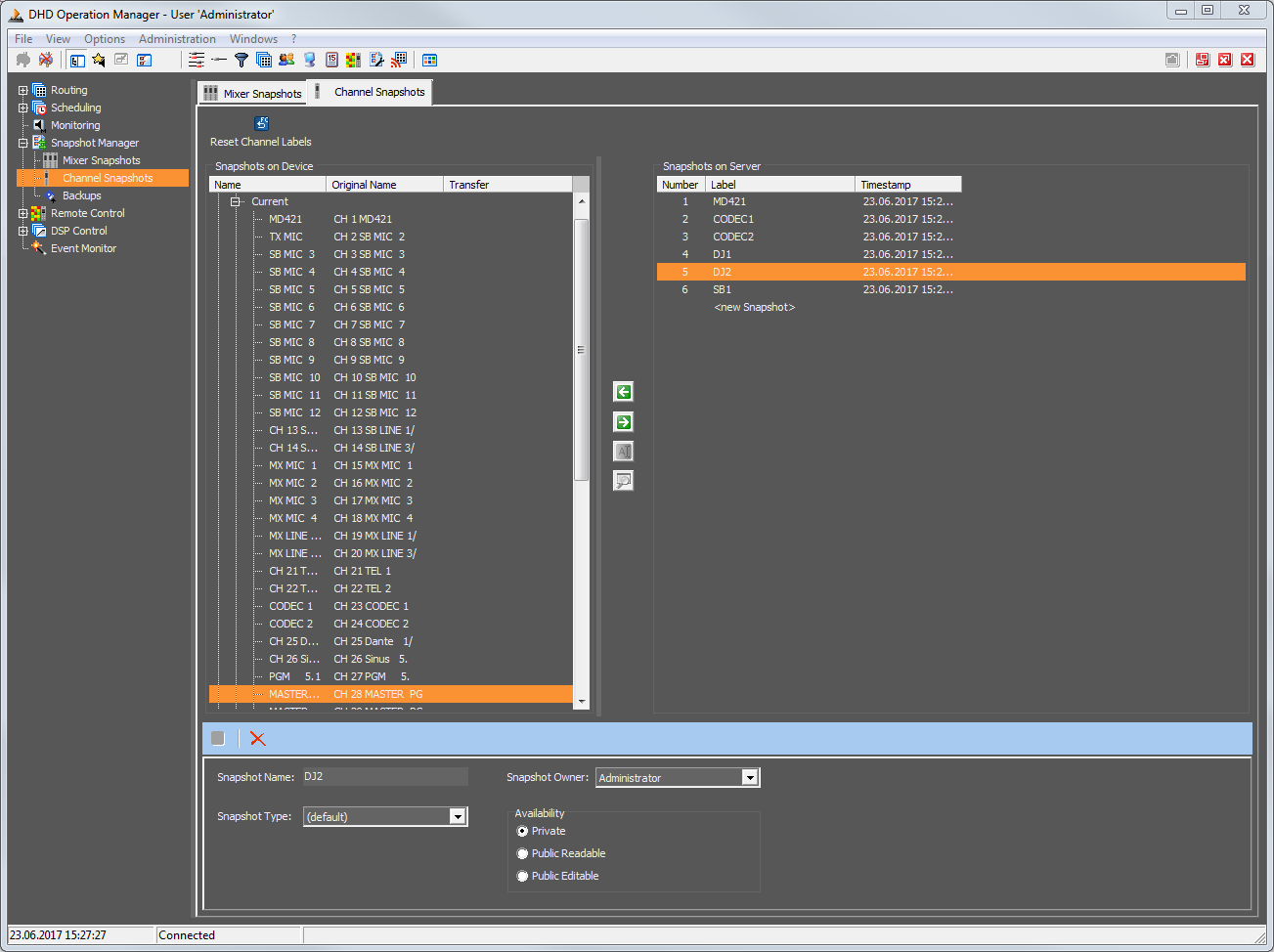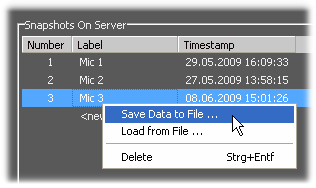Channel Snapshots
Double click the entry Channel Snapshots (this is a child entry of the Snapshot Manager) in the list on the left-hand side of the DHDOM window to open the Channel Snapshots tab.
On the one hand you have channel snapshots stored in the devices (shown in the list Snapshots On Device) and on the other hand, you have snapshots saved on the server PC (listed in the field Snapshots On Server). By using drag'n'drop or the arrow buttons between the lists you can copy channel snapshots from the device to the server and vice versa.
Please understand the snapshots on the device and the server as named containers for snapshot parameters. Since only the parameters of these containers are exchanged, the names are not overwritten by transferring a channel snapshot from the device to the server or vice versa.
Besides the 250 free configurable channel snapshots, you can find the current state of all Fader Channels of the mixer (Current) in the list on the left side of the window. The server side shows all saved snapshots and the entry <new Snapshot>.
Note
If not all conditions are met, it is not possible to transfer a snapshot. Please see the table in the section Snapshot Transfer Conditions if you are not able to transfer snapshots.
Furthermore, you can copy the saved channel snapshots from the server database to another folder, drive or PC.
Right-click a snapshot in the right-handed list to open the contextual menu. Choose the command Save Data to File to save a copy of the snapshot in a file. Use the entry Load from File to load a saved snapshot. Delete removes the snapshot or use the shortcut Ctrl + Del. Another possibility to delete the currently selected snapshot on the server is to click the  symbol. The date in the
symbol. The date in the Timestamp column shows the time the snapshot was created or when the snapshot content was overwritten last.
If you have selected a snapshot on the server, the snapshot editing section is shown at the bottom of the window. Herein, the snapshot can be defined as Private, Public Visible or Public Writeable. Public Visible means, the snapshot can be seen and loaded by everyone. Select Public Writeable to give all users the possibility to overwrite the snapshot and to change the settings provided in this section. If the Private option is activated, other users can not use the snapshot in any way. Users with administrative rights can always see and edit all snapshots.
The owner of the snapshot is shown in the field Snapshot Owner. Administrators and the owner of the snapshot are able to assign a new snapshot owner.
The Fader Channels of the console and the snapshots on the device and on the server can have an assigned Snapshot Type. The purpose of these snapshot types is to separate channel snapshots in different groups. This makes it possible to define which authorisation groups are allowed to save and to overwrite specific snapshots. These snapshot types need to be created within the configuration process in the Toolbox5 software. For the snapshots on the server, you can select another group in the Snapshot Type pull-down menu.
For organization purposes, the snapshots can be renamed in the field Snapshot Name.
After you have changed the settings, the  symbol is active and you can save your settings by clicking the symbol.
symbol is active and you can save your settings by clicking the symbol.
The labels of the snapshots in the list Snapshots On Device can be changed. Click the  symbol between the lists. Alternatively, you can right-click the snapshot in the Snapshots On Device list and select
symbol between the lists. Alternatively, you can right-click the snapshot in the Snapshots On Device list and select Rename Snapshot. The Rename Device Snapshot window appears. Enter the new snapshot name and press enter. The Current states have two names. At first the name you have entered and secondly the original name (the name of the Fader Channel). The names are identical if you have not entered a new name. If you want to reset the snapshot names, click on the  symbol. A contextual menu appears and you have to select whether you want to reset the channel snapshot labels of all virtual mixers or only for the currently selected one. Finally, click
symbol. A contextual menu appears and you have to select whether you want to reset the channel snapshot labels of all virtual mixers or only for the currently selected one. Finally, click  to transmit the changes to the device.
to transmit the changes to the device.
Moreover, it is possible to read out the saved parameters of snapshots on the device and on the server. Click the  symbol between the lists to open the
symbol between the lists to open the Snapshot Content window.

